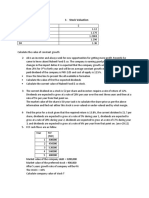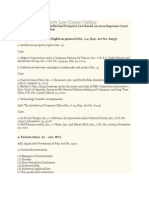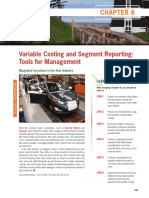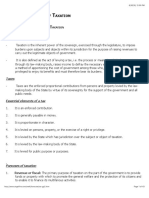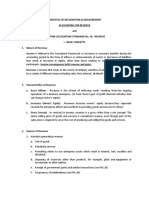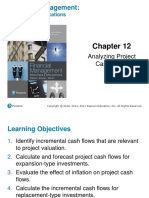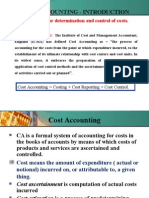Basic Accounting Terms List
Basic Accounting Terms List
Uploaded by
Mahadi HasanCopyright:
Available Formats
Basic Accounting Terms List
Basic Accounting Terms List
Uploaded by
Mahadi HasanOriginal Description:
Original Title
Copyright
Available Formats
Share this document
Did you find this document useful?
Is this content inappropriate?
Copyright:
Available Formats
Basic Accounting Terms List
Basic Accounting Terms List
Uploaded by
Mahadi HasanCopyright:
Available Formats
Basic Accounting Terms List
1. Accounts Receivable AR
Definition: The amount of money owed by your customers after goods or services have been
delivered and/or used.
2. Accounting ACCG
Definition: A systematic way of recording and reporting financial transactions.
3. Accounts Payable AP
Definition: The amount of money you owe creditors (suppliers, etc.) in return for good and/or
services they have delivered.
4. Assets (Fixed and Current) FA and CA
Definition: Current assets are those that will be used within one year. Typically this could be
cash, inventory or accounts receivable. Fixed assets (non current) are more long-term and will
likely provide benefits to a company for more than one year, such as a building, land or
machinery.
5. Balance Sheet BS
Definition: A financial report that summarizes a company's assets (what it owns), liabilities (what
it owes) and owners equity at a given time.
6. Capital CAP
Definition: A financial asset and its value, such as cash or goods. Working capital is calculated
by taking your current assets subtracted from current liabilities.
7. Cash Flow CF
Definition: The revenue or expense expected to be generated through business activities (sales,
manufacturing, etc.) over a period of time. Having a positive cash flow is essential in order for
businesses to survive in the long run.
8. Certified Public Accountant CPA
Definition: A designation given to someone who has passed a standardized CPA exam and met
government-mandated work experience and educational requirements to become a CPA.
9. Cost of Goods Sold COGS
Definition: The direct expense related to producing the goods sold by a company. This may
include the cost of the raw materials (parts) and amount of employee labor used in production.
10. Credit CR
Definition: An accounting entry that may either decrease assets or increase liabilities and equity
on the company's balance sheet, depending on the transaction. When using the double-entry
accounting method there will be two recorded entries for every transaction: a credit and a debit.
11. Debit DR
Definition: An accounting entry where there is either an increase in assets or a decrease in
liabilities on a company's balance sheet.
12. Expenses (Fixed, Variable, Accrued, Operation) FE, VE, AE, OE
Definition: The fixed, variable, accrued or day-to-day costs that a business may incur through its
operations. Examples of expenses include payments to banks, suppliers, employees or
equipment.
13. Generally Accepted Accounting Principles GAAP
Definition: A set of rules and guidelines developed by the accounting industry for companies to
follow when reporting financial data. Following these rules is especially critical for all publicly
traded companies.
14. General Ledger GL
Definition: A complete record of the financial transactions over the life of a company.
15. Liabilities (Current and Long-Term) CL and LTL
Definition: A company's debts or financial obligations it incurred during business operations.
Current liabilities are those debts that are payable within a year, such as a debt to suppliers.
Long-term liabilities are typically payable over a period of time greater than one year. An
example of a long-term liability would be a bank loan.
16. Net Income NI
Definition: A company's total earnings, also called net profit or the bottom line. Net income
is calculated by subtracting totally expenses from total revenues.
17. Owner's Equity OE
Definition: An owners equity is typically explained in terms of the percentage amount of stock a
person has ownership interest in the company. The owners of the stock are commonly referred to
as the shareholders.
18. Present Value PV
Definition: The value of how much a future sum of money is worth today. Present value helps us
understand how receiving $100 now is worth more than receiving $100 a year from now. See an
example of the time value of money here.
19. Profit and Loss Statement P&L
Definition: A financial statement that is used to summarize a companys performance and
financial position by reviewing revenues, costs and expenses during a specific period of time;
such a quarterly or annually.
20. Return on Investment ROI
Definition: A measure used to evaluate the financial performance relative to the amount of
money that was invested. The ROI is calculated by dividing the net profit by the cost of the
investment. The result is often expressed as a percentage. See an example here.
You might also like
- Administrative AccountabilityDocument26 pagesAdministrative AccountabilitySaji JimenoNo ratings yet
- Accounting Terms & DefinitionsDocument6 pagesAccounting Terms & DefinitionsMir Wajid KhanNo ratings yet
- Glossary Accounts A To ZDocument8 pagesGlossary Accounts A To Zritvikjindal100% (1)
- 2go Group IncDocument7 pages2go Group IncSheenah FerolinoNo ratings yet
- Stock ValuationDocument2 pagesStock Valuationxaud qureshiNo ratings yet
- FinMar ReivewerDocument16 pagesFinMar ReivewerChealseah MerceneNo ratings yet
- Law - On - Pledge - Real - Estate - Mortgage - Chattel - Mortgage - Antichresis - gROUP 6Document50 pagesLaw - On - Pledge - Real - Estate - Mortgage - Chattel - Mortgage - Antichresis - gROUP 6Aldrin Frank ValdezNo ratings yet
- Exam TaxationDocument8 pagesExam TaxationRandy ManzanoNo ratings yet
- Intellectual Property Law Course OutlineDocument5 pagesIntellectual Property Law Course OutlineortizluismichaelNo ratings yet
- Notes On Classification of Costs and Cost ConceptsDocument5 pagesNotes On Classification of Costs and Cost ConceptsAngela Mae Balanon RafananNo ratings yet
- Chapter 1 - Fundamental Financial Management Concepts (Student's Copy)Document23 pagesChapter 1 - Fundamental Financial Management Concepts (Student's Copy)Julie Mae Caling MalitNo ratings yet
- Mas 05 - Differential CostingDocument5 pagesMas 05 - Differential CostingCarl Angelo LopezNo ratings yet
- RBG Corporation Code ComparisonDocument30 pagesRBG Corporation Code ComparisonLakbay BiyaheroNo ratings yet
- Introduction To Income Tax Full Coverage 1Document35 pagesIntroduction To Income Tax Full Coverage 1Julian VillanuevaNo ratings yet
- Managerial Accounting 15th Ed. GNB - Chapter 6 Variable CostingDocument11 pagesManagerial Accounting 15th Ed. GNB - Chapter 6 Variable CostingAivie PangilinanNo ratings yet
- Managerial Accounting and The Business Environment: Chapter OneDocument26 pagesManagerial Accounting and The Business Environment: Chapter Oneরুপকথার রাজকুমারNo ratings yet
- Explain and Assess The Major Areas of Organizational Life Affected by Issues in CGDocument3 pagesExplain and Assess The Major Areas of Organizational Life Affected by Issues in CGGenicallyAudeNo ratings yet
- Commercial Law Reviewer, MercantileDocument60 pagesCommercial Law Reviewer, MercantilecelestezerosevenNo ratings yet
- At 3Document8 pagesAt 3Ley EsguerraNo ratings yet
- Value Added Tax-Summary LectureDocument18 pagesValue Added Tax-Summary LectureUy SamuelNo ratings yet
- Quality Certification: Click To Edit Master Subtitle StyleDocument31 pagesQuality Certification: Click To Edit Master Subtitle StyleRaj DangeNo ratings yet
- TX01 - General Principles of TaxationDocument9 pagesTX01 - General Principles of TaxationDon XiaoNo ratings yet
- What Is Strategic Business Analysis?: Vision, Mission, and ValuesDocument6 pagesWhat Is Strategic Business Analysis?: Vision, Mission, and ValuesJoseph VillartaNo ratings yet
- D. Factory Overhead Costs Incurred Were Less Than Overhead Costs Charged To ProductionDocument4 pagesD. Factory Overhead Costs Incurred Were Less Than Overhead Costs Charged To ProductionGuinevereNo ratings yet
- Optional Standard DeductionDocument3 pagesOptional Standard DeductionYuvia Keithleyre100% (1)
- Inherent Powers - Similarities and DifferencesDocument1 pageInherent Powers - Similarities and DifferencesJudge JudgeNo ratings yet
- Negotiorum Gestio Reimbursement: Personal (Ac Tor Service)Document20 pagesNegotiorum Gestio Reimbursement: Personal (Ac Tor Service)LabLab Chatto100% (1)
- Auditing 9.1Document2 pagesAuditing 9.1Muhamad Fajar MukharamNo ratings yet
- Budgeting - Seatwork MaDocument11 pagesBudgeting - Seatwork MaErica Caliuag100% (1)
- Chaper 2 Taxes, Tax, Laws and Tax AdministrationDocument35 pagesChaper 2 Taxes, Tax, Laws and Tax AdministrationPearlyn VillarinNo ratings yet
- Forex. HandoutDocument4 pagesForex. HandoutKj TaccabanNo ratings yet
- Quiz4-Responsibilityacctg TP BalscoreDocument5 pagesQuiz4-Responsibilityacctg TP BalscoreRambell John RodriguezNo ratings yet
- Chapter 6. Prohibited Transactions (Enzo)Document14 pagesChapter 6. Prohibited Transactions (Enzo)Kyle DionisioNo ratings yet
- 1.0 Course Pack (Module) - Partnership Law (Notes and Activities) PDFDocument15 pages1.0 Course Pack (Module) - Partnership Law (Notes and Activities) PDFIm NayeonNo ratings yet
- BLT 2012 First Pre-Board July 28Document14 pagesBLT 2012 First Pre-Board July 28Lester AguinaldoNo ratings yet
- General Principles of TaxationDocument43 pagesGeneral Principles of TaxationChristine Joy Rejas-TubianoNo ratings yet
- Chapter IV Gross Income NotesDocument5 pagesChapter IV Gross Income NotesJasmin AlapagNo ratings yet
- Liquidation Based Valuation 03.06.2023Document6 pagesLiquidation Based Valuation 03.06.2023Ivan Jay E. EsminoNo ratings yet
- Law On Sales Lecture 1Document13 pagesLaw On Sales Lecture 1Leo TajortelliNo ratings yet
- Foreign Investment 1991 RA 7042Document44 pagesForeign Investment 1991 RA 7042MikhailFAbzNo ratings yet
- Financial Accounting and Reporting - PAS No. 18 Accounting For RevenueDocument15 pagesFinancial Accounting and Reporting - PAS No. 18 Accounting For RevenueLuisitoNo ratings yet
- NovDocument47 pagesNovNeb GarcNo ratings yet
- Stracos Module 1 Quiz Cost ConceptsDocument12 pagesStracos Module 1 Quiz Cost ConceptsGemNo ratings yet
- c7 Review QuestionsDocument5 pagesc7 Review QuestionsPauline100% (1)
- 1st Quiz - Business ComDocument2 pages1st Quiz - Business ComPeter GonzagaNo ratings yet
- Case Digests Part 1Document10 pagesCase Digests Part 1Mary BalojaNo ratings yet
- CHAPTER-3 Small BusinessDocument18 pagesCHAPTER-3 Small BusinessmohammedkasoNo ratings yet
- Obligations and Rights of Mortgagor and MortgageeDocument1 pageObligations and Rights of Mortgagor and Mortgageesummer amberNo ratings yet
- 7 Financial Management Part 3Document5 pages7 Financial Management Part 3Riz CanoyNo ratings yet
- Presentation On Variable and Absorption CostingDocument24 pagesPresentation On Variable and Absorption Costingsmurtazaali84No ratings yet
- 10 X08 BudgetingDocument13 pages10 X08 Budgetingjenna hannahNo ratings yet
- 8 Conceptual Payroll Sytem ProcedureDocument2 pages8 Conceptual Payroll Sytem ProcedureEva DagusNo ratings yet
- Mock BarDocument3 pagesMock BarAe-cha Nae GukNo ratings yet
- Preference of CreditsDocument9 pagesPreference of CreditsJovy Balangue MacadaegNo ratings yet
- Illustrative Examples - Biological AssetsDocument3 pagesIllustrative Examples - Biological AssetsChuchi SubardiagaNo ratings yet
- Corporation: Title XVDocument9 pagesCorporation: Title XVDarrel SapinosoNo ratings yet
- Platinum Plans Phils. Inc Vs Cucueco 488 Scra 156Document4 pagesPlatinum Plans Phils. Inc Vs Cucueco 488 Scra 156Anonymous b7mapUNo ratings yet
- 2 Inventory Cost Flow Intermediate Accounting ReviewerDocument3 pages2 Inventory Cost Flow Intermediate Accounting ReviewerDalia ElarabyNo ratings yet
- Cost Terminology and Cost Behaviors: Cost Accounting: Foundations & Evolutions, 8eDocument19 pagesCost Terminology and Cost Behaviors: Cost Accounting: Foundations & Evolutions, 8eMa Ac SitacaNo ratings yet
- Chapter 6: Investing Abroad DirectlyDocument30 pagesChapter 6: Investing Abroad DirectlyYagmyrNo ratings yet
- Double Entry Bookkeeping Debiting Crediting Accounting Equation Accounting Information System Specialized Journals Adjusting EntriesDocument3 pagesDouble Entry Bookkeeping Debiting Crediting Accounting Equation Accounting Information System Specialized Journals Adjusting Entrieswesternwound82No ratings yet
- Bangladesh Can Become Export PowerhouseDocument2 pagesBangladesh Can Become Export PowerhouseMahadi HasanNo ratings yet
- Money LaunderingDocument9 pagesMoney LaunderingMahadi HasanNo ratings yet
- Information Technology in The Banking Sector - Opportunities, Threats and StrategiesDocument7 pagesInformation Technology in The Banking Sector - Opportunities, Threats and StrategiesMahadi HasanNo ratings yet
- Executive SummaryDocument92 pagesExecutive SummaryMahadi HasanNo ratings yet
- Letter of CertificateDocument1 pageLetter of CertificateMahadi HasanNo ratings yet
- GDP Grows Faster Than Forecast in FY16Document2 pagesGDP Grows Faster Than Forecast in FY16Mahadi HasanNo ratings yet
- Payra Seaport - A Pathfinder To EconomyDocument3 pagesPayra Seaport - A Pathfinder To EconomyMahadi Hasan75% (4)
- Retail Banking in BangladeshDocument4 pagesRetail Banking in BangladeshMahadi HasanNo ratings yet
- Grammatical Rules - 90Document17 pagesGrammatical Rules - 90Mahadi HasanNo ratings yet
- 37th BCS Question Solution-EnglishDocument3 pages37th BCS Question Solution-EnglishMahadi HasanNo ratings yet
- Digital Bangladesh and AchievementDocument10 pagesDigital Bangladesh and AchievementMahadi HasanNo ratings yet
- Customer Service As A Differentiator' - A Cross-Sectional Study of The Mobile Market of BangladeshDocument28 pagesCustomer Service As A Differentiator' - A Cross-Sectional Study of The Mobile Market of BangladeshMahadi HasanNo ratings yet
- MCQ English Literature - Manish RustogiDocument210 pagesMCQ English Literature - Manish RustogiMahadi Hasan100% (2)
- 40 Sentence Equivalence Questions Collected From Real GRE ExamsDocument16 pages40 Sentence Equivalence Questions Collected From Real GRE ExamsMahadi HasanNo ratings yet
- Sentence CompletionDocument22 pagesSentence CompletionMahadi HasanNo ratings yet
- 40 Sentence Equivalence Questions Collected From Real GRE ExamsDocument16 pages40 Sentence Equivalence Questions Collected From Real GRE ExamsMahadi HasanNo ratings yet
- Final Project of Cost AccountingDocument16 pagesFinal Project of Cost AccountingMariya Saeed100% (1)
- Akuntansi-Predicting Future Operating Cash FlowsDocument104 pagesAkuntansi-Predicting Future Operating Cash FlowsYoyok Dwi Parindra100% (1)
- Audit Committee CharterDocument39 pagesAudit Committee CharterozlemNo ratings yet
- Tyler Schwantes: Bachelor of Management Information Systems, December, 2012Document4 pagesTyler Schwantes: Bachelor of Management Information Systems, December, 2012Tyler SchwantesNo ratings yet
- Pre TestDocument2 pagesPre TestLaisa BartoloNo ratings yet
- Installment T SalesDocument31 pagesInstallment T SalesNiki DimaanoNo ratings yet
- FINANCIAL STATEMENT (CMA) - by CMA Srinivas Reddy (LETSLEARN GLOBAL)Document44 pagesFINANCIAL STATEMENT (CMA) - by CMA Srinivas Reddy (LETSLEARN GLOBAL)Srinivas Muchantula100% (5)
- TMG Consolidated FS 12-2020 - Final - EngDocument44 pagesTMG Consolidated FS 12-2020 - Final - EngAly A. SamyNo ratings yet
- TACN3Document25 pagesTACN3Tuấn VũNo ratings yet
- Unit 4-1Document58 pagesUnit 4-1Tasneem khanNo ratings yet
- Invoice Template Ignacio - PDF - DocHubDocument1 pageInvoice Template Ignacio - PDF - DocHubnastyfergNo ratings yet
- Oracle EBS - P2P TrainingDocument26 pagesOracle EBS - P2P TrainingNguyễn Ngọc ĐiểnNo ratings yet
- Program ID Details: Front OfficeDocument2 pagesProgram ID Details: Front OfficeNimeshNo ratings yet
- Tally - Erp 9 Release NotesDocument209 pagesTally - Erp 9 Release NotesMohan GoyalNo ratings yet
- Laporan Magang Final TTDDocument189 pagesLaporan Magang Final TTDGRACIANo ratings yet
- Fae3e SM ch02Document42 pagesFae3e SM ch02JarkeeNo ratings yet
- 80379icai - Official - Directory 2024 25 v2Document236 pages80379icai - Official - Directory 2024 25 v2Pratima JainNo ratings yet
- Gloria Macapagal - Arroyo v. People, G.R. No. 220598, July 19, 2016Document49 pagesGloria Macapagal - Arroyo v. People, G.R. No. 220598, July 19, 2016Jerry Serapion0% (1)
- CFAS With KeyDocument5 pagesCFAS With KeyChesca Marie Arenal PeñarandaNo ratings yet
- Materi Lab 6 - Audit of The Inventory and Warehousing CycleDocument30 pagesMateri Lab 6 - Audit of The Inventory and Warehousing CycleMuflikh ZenithNo ratings yet
- Fundamentals of Financial Accounting, 7E Ise 7Th/Ise Edition Fred Phillips - Ebook PDFDocument41 pagesFundamentals of Financial Accounting, 7E Ise 7Th/Ise Edition Fred Phillips - Ebook PDFmagonaboriszNo ratings yet
- PROBLEMS - Partnership DissolutionDocument4 pagesPROBLEMS - Partnership DissolutionA. MagnoNo ratings yet
- Titman PPT CH12Document71 pagesTitman PPT CH12Rosita NoorNo ratings yet
- Assistant Professor Dept. of Commerce Shift - I ST - Thomas College of Arts and Science Koyambedu, Chennai-107Document87 pagesAssistant Professor Dept. of Commerce Shift - I ST - Thomas College of Arts and Science Koyambedu, Chennai-107123456No ratings yet
- Nacua CAC Unit2 ActivityDocument13 pagesNacua CAC Unit2 ActivityJasper John NacuaNo ratings yet
- It FinalsDocument11 pagesIt FinalsHea Jennifer AyopNo ratings yet
- Introduction To Cost Accounting - Module 1Document49 pagesIntroduction To Cost Accounting - Module 1Sonali Jagath0% (1)
- Wey MGRL 9e ExProbB Ch07 Incremental-AnalysisDocument9 pagesWey MGRL 9e ExProbB Ch07 Incremental-AnalysisElleana YauriNo ratings yet
- Auditing-II CH 5Document56 pagesAuditing-II CH 5Tesfaye DesalegnNo ratings yet




